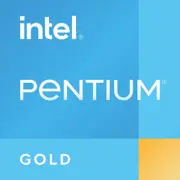Intel Pentium Gold G6500

Intel Pentium Gold G6500: budgetfreundlicher Prozessor für grundlegende Aufgaben im Jahr 2025
April 2025
Wichtige Merkmale: Was bietet der Pentium Gold G6500?
Der Intel Pentium Gold G6500, der 2020 auf den Markt kam, bleibt immer noch eine beliebte Wahl für budgetfreundliche Builds. Trotz seines Alters bleibt er dank des ausgewogenen Verhältnisses von Preis und Grundleistung relevant.
Architektur und Fertigungstechnik
- Codename: Comet Lake-S (14 nm).
- Kerne/Threads: 2 Kerne, 4 Threads (Hyper-Threading).
- Taktfrequenz: Basis — 4,1 GHz, Turbo-Modus ist nicht verfügbar.
- Cache: 4 MB L3.
- Integrierte Grafik: Intel UHD Graphics 630 (Basisfrequenz — 350 MHz, maximal — 1,1 GHz).
Leistung
- Geekbench 6: 821 (einzelner Kern), 1700 (mehrere Kerne).
- TDP: 58 W.
Hauptmerkmale
- Unterstützung für DDR4-2666-RAM.
- Integrierte Grafik für die Arbeit mit 4K-Inhalten.
- Kompatibilität mit Windows 11 (erfordert Aktivierung von TPM 2.0 auf dem Motherboard).
Kompatible Mainboards: Wie wählt man aus?
Der Prozessor verwendet den Sockel LGA 1200, was die Auswahl an Mainboards auf Chipsatz-Serien der 400er und 500er einschränkt.
Empfohlene Chipsätze
- H410/B460: Budget-Boards (z.B. ASRock H410M-HDV, ~$60). Geeignet für Büro-PCs.
- H470/Z490: Für Upgrades (z.B. Gigabyte Z490 UD, ~$120). Unterstützen das Übertakten von RAM und schnellere SSDs.
Merkmale der Auswahl
- Überprüfen Sie die BIOS-Version: Einige Boards benötigen ein Update, um mit dem Pentium G6500 zu funktionieren.
- Vermeiden Sie Boards mit Chipsätzen der Serie 500 (z.B. H510), wenn ein Wechsel zur 11. Intel-Generation nicht geplant ist.
Unterstützter Speicher: DDR4 und Dual-Channel-Modus
Der Prozessor arbeitet nur mit DDR4 (maximale Frequenz — 2666 MHz).
- Empfehlungen:
- Verwenden Sie 2 RAM-Module (z.B. 2x8 GB DDR4-2666), um den Dual-Channel-Modus zu aktivieren. Dies erhöht die Leistung der UHD 630-Grafik um 15-20%.
- Vermeiden Sie DDR5: Der Prozessor und der Sockel LGA 1200 unterstützen den neuen Standard nicht.
Beispiel: Patriot Signature DDR4-2666 16 GB (2x8 GB) kostet ~$45 (2025).
Netzteil: Wie viel Watt wird benötigt?
Mit einem TDP von 58 W ist der Prozessor äußerst energieeffizient.
- Ohne dedizierte Grafikkarte: Ein Netzteil mit 300-400 W reicht aus (z.B. EVGA 400 N1, ~$35).
- Mit Grafikkarte: Für Modelle wie die NVIDIA GTX 1650 (TDP 75 W) sollten Sie ein Netzteil mit 450-500 W wählen (Cooler Master MWE 500 Bronze, ~$55).
Wichtig: Selbst günstige Netzteile meistern den Pentium G6500, aber sparen Sie nicht an der Qualität — ein Risiko für die Komponenten sollten Sie vermeiden.
Vor- und Nachteile des Pentium Gold G6500
Vorteile:
- Günstiger Preis (~$75 für neue Exemplare im Jahr 2025).
- Energieeffizienz (geeignet für Mini-PCs).
- Integrierte Grafik für 4K-Videos und leichte Spiele.
Nachteile:
- Nur 2 Kerne: Multitasking ist eingeschränkt.
- Keine Unterstützung für PCIe 4.0 (nur PCIe 3.0).
- Die 14-nm-Architektur ist im Vergleich zu den 7-nm AMD Ryzen 3 veraltet.
Einsatzszenarien: Für wen geeignet?
1. Büroaufgaben: Arbeiten mit Dokumenten, Browser, Zoom.
- Beispiel: PC mit 8 GB DDR4 und SSD bootet Windows 11 in 10-12 Sekunden.
2. Multimedia: Streaming von 4K-Videos (Netflix, YouTube) über HDMI 1.4.
- Einschränkung: HDR wird nicht unterstützt.
3. Leichte Spiele:
- CS:GO — 720p, niedrige Einstellungen, ~50-60 FPS.
- Minecraft — 1080p, ~60 FPS.
4. Heimserver: Niedriger Stromverbrauch ist nützlich für NAS.
Vergleich mit Konkurrenten
1. AMD Athlon 3000G (2C/4T, Vega 3):
- Günstiger (~$60), aber schwächer in Einzelkern-Tests (Geekbench 6: ~700).
2. Intel Core i3-10100 (4C/8T):
- 30% schneller im Multithreading (Geekbench 6: ~2500), aber teurer (~$110).
3. AMD Ryzen 3 3200G (4C/4T, Vega 8):
- Bessere Grafik und 4 Kerne (~$90), aber höheres TDP (65 W).
Fazit: Der Pentium G6500 ist eine Option für diejenigen, die sparen möchten, aber nicht zu AMD wechseln wollen.
Praktische Tipps für den Build
1. Mainboard: Wählen Sie B460 für ein Upgrade auf Core i5-10400.
2. Speicher: Unbedingt SSD (z.B. Kingston A400 240 GB, ~$25).
3. Kühlung: Der Standard-Box-Kühler reicht aus.
4. Gehäuse: Mini-Format (Fractal Design Core 1100, ~$45) für Kompaktheit.
Beispiel Build:
- Prozessor: Pentium G6500 — $75.
- Mainboard: ASRock B460M-HDV — $70.
- RAM: 16 GB DDR4-2666 — $45.
- SSD: 240 GB — $25.
- PSU: EVGA 400W — $35.
- Insgesamt: ~$250 (ohne Gehäuse).
Schlussfolgerung: Für wen ist der Pentium Gold G6500 geeignet?
Dieser Prozessor ist eine gute Wahl, wenn:
- Ein PC für Internet, Büro oder Medienzentrum benötigt wird.
- Das Budget auf $250-300 begrenzt ist.
- Keine Pläne bestehen, anspruchsvolle Programme oder Spiele zu verwenden.
Warum gerade dieser?
- Der niedrigste Preis im Intel-Segment.
- Einfache Zusammenstellung ohne komplizierte Einstellungen.
- Ausreichend leistungsfähig für grundlegende Aufgaben im Jahr 2025.
Für Spiele oder grafisch intensive Arbeiten ist es jedoch besser, eine Grafikkarte (z.B. NVIDIA GTX 1650) hinzuzufügen oder zu Ryzen 3 zu wechseln. Ansonsten ist dies ein zuverlässiger "Arbeitstier" für den Alltag.
Basic
CPU-Spezifikationen
Speicherspezifikationen
GPU-Spezifikationen
Verschiedenes
Benchmarks
Im Vergleich zu anderen CPUs
In sozialen Medien teilen
Oder verlinken Sie uns
<a href="https://cputronic.com/de/cpu/intel-pentium-gold-g6500" target="_blank">Intel Pentium Gold G6500</a>